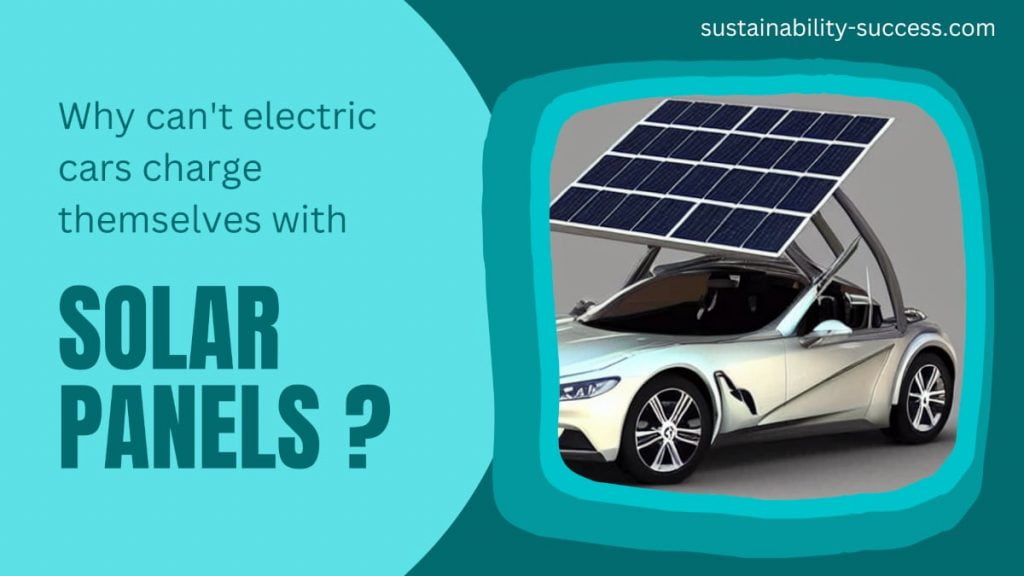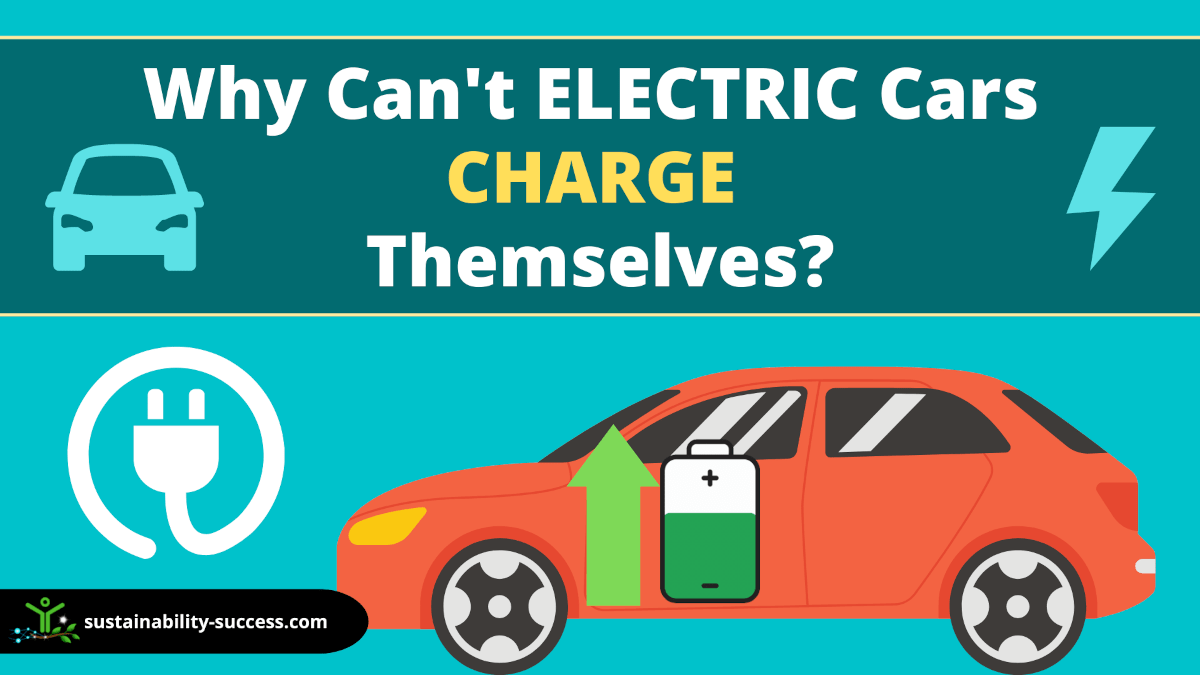Electric cars provide low fuel costs and less emissions compared to traditional gasoline-powered vehicles. They offer numerous benefits, however, why can’t electric cars charge themselves? Why can’t an electric car charge itself? Do electric cars charge while driving? Would you like a self charging electric car?
The key barrier is that the necessary technology for a fully self-charging electric vehicle does not yet exist. The average electric car today uses a 60-100 kWh lithium-ion battery pack. Even with regenerative braking, only 10-15% of discharged energy can currently be recovered while driving. That is not enough to offset the typical energy usage while operating an EV.
Why Can’t Electric Cars Charge Themselves?
While driving an electric car you are simply using the energy that was previously stored in its batteries. As such, an electric car is using energy while on the go, and as long as it doesn’t have enough solar panels on the roof (more on this later in the article), it will not be able to fully charge itself.
It is true that it is possible to recover some of the used energy while driving electric cars. However, the recovered energy will be much less compared to the used one, because much of the kinetic energy is lost in the form of heat.
Note that the technology for self-charging cars has not been developed so far. Currently, there is no modern infrastructure that supports electric cars charging themselves (for example while they are in car parks).
Finally, there are no governments supporting this, which makes it even harder to make progress in this field. Still, scientists are making some progress in this sector; and even though their progress is minimal, there is still hope that electric trucks and cars will be self-charging in the future.
The available technologies for an electric car to charge itself
I will now go through the existing technologies that an electric car could use to charge itself. However, as explained earlier, the charge for using those techs will be only partial.
So, how do electric cars charge while driving?
1. Regenerative braking
Nowadays, electric cars are designed to recover some of the used energy using regenerative brakes. The regenerative braking system is a key feature of electric cars like Tesla. This system converts the kinetic energy of the car back into electricity, which can then be used to power the car. This makes electric cars very efficient and easy to drive.
For example, the Tesla Model S is using a simple transmission and a clever regenerative braking system that can turn its electric motor into a generator when the car is decelerating. This means that when you lift your foot from the pedal the car will slow down not just because you are cutting the power to the motor. In fact, at that point, the motor will start acting as a generator and convert kinetic energy back into electricity.
This not only helps to recover some power but also makes the car easier to drive because you would expect the car to slow down when you remove your foot from the pedal. This would not happen on an electric car if there wasn’t a regenerative braking system.
A similar system but with different mechanisms can also be installed on standard internal combustion engine cars. This is the kinetic energy recovery system (KERS) and is a unique type of braking system that converts the kinetic energy of the car back into electricity while the car is breaking.

Regenerative braking systems have been extensively researched and developed in Formula 1. This is a nice example of how motorsport can be used to promote research on technologies that help environmental sustainability.
Either way, the recovered electricity is then stored in electric car batteries and used when needed.
Since regenerative braking uses kinetic energy while the car is breaking or decelerating, it only works when the car decelerates or needs to break often, like for example in urban areas.
For this reason, regenerative braking is a great addition to extend the range of an electric car driving in the city but it will have minimum to almost no effect if you drive most of the time on a highway.
However, in any case, the energy recovered in this way will always be a lot less than the used one, because the breaks are still going to get hot and in doing so, they dissipate energy.
Regenerative braking is majorly considered a form of self-charging and is currently used by hybrid cars (learn the differences between hybrid vs electric cars), which by the way still use gas as well. However, while it may count as a form of self-charging, it is not effective enough to charge an electric car fully. After all, the unique form of breaking only captures a small amount of energy, which is not enough to allow the electric vehicle to recharge itself fully.
Can an electric car charge while driving?
Yes, but only partially! Regenerative braking is used to charge the electric car while driving. However, this system can charge the car’s battery only when the car is decelerating or braking.
2. Solar Panels

Solar panels are considered the most environmentally conscious option for recharging electric vehicles. However, isn’t it strange that in most cases those are not installed on the roof of electric cars to allow them to charge themselves?
The main reason why solar panels are generally not installed on electric cars is simply that they will not generate enough power to charge the car.
Just visualize for a minute the size of your electric car. Its roof is not that large, isn’t it? At the same time, an electric car needs to store a lot of energy to move around. That’s why it has so many batteries.
The problem is that current PV panels have a maximum efficiency of about 25%. With this in mind, it is easy to understand that there simply isn’t enough solar energy arriving on the car’s surface to fully charge it.
Moreover, the energy that could be harvested from solar panels placed on top of the electric car will only be enough to power some minor systems.
How many solar panels would an electric car need to charge itself on the go?
A useful comparison that could give you a better idea about the problem is to have a look at solar catamarans. Yes, while the existing tech is not good enough for an electric car to charge itself, it is possible to have fully self-charging solar catamarans, such as the ones of Silent Yachts!
Those electric catamarans were even able to cross the Atlantic Ocean just using solar!
Well, by doing a quick calculation, even the smallest version of those electric catamarans has a top surface (exposed to the sun) that is about 16.8 times larger than a Tesla. On the other hand, the smallest Silent Yacht has only about 2 times the battery capacity of a Tesla to charge.
This means that a Tesla electric car will likely need to be about 8 times larger than its current size to be able to fully charge itself on the go just using solar power with the existing tech.
Portable solar panels to charge an electric car
While there aren’t good enough solar panels to fully charge an electric car on the go, there are options available to charge your car while in a car park.
I am referring to portable solar panels to temporarily place on top of your electric car to charge it while it is parked.
Those can be useful if you don’t have access to a charging station and for you is important to gain even just a bit of charge.
The drawbacks of those portable solar panes are that they are not enough to fully charge the electric car and you also risk that someone may steal them from the car while you are away.
Ongoing research and prototypes
Solar panels may soon be available on the roof of the new Tesla, however, those will be capable enough just to extend its range.
Also, a group of Dutch developers created an electric car prototype powered by solar panels: The Lightyear 0.
According to the developers, this solar-powered car can travel up to 388 miles with a fully-charged battery. What’s even better, the solar panels can extend the car’s range on the go by up to 70 miles!
However, even though the Lightyear 0 has been successful in creating partially self-charging electric cars using solar panels, there are still several technical issues to be overcome. For example, the vehicle has not yet been tested, which makes it almost impossible to determine its long-term ability.
Also, the solar panels do not charge the vehicles very quickly, which makes them only ideal to extend the car’s range while leaving home with the battery already fully charged!
And as for the pricing of the cars, they are quite expensive, with one Lightyear 0 car being sold for more than $200’000.
Therefore, until we will have much more efficient solar panels, we still have a long way to go when it comes to using PV solar panels to charge electric vehicles.
How Would a Self-Charging Electric Car Work?

Researchers have come up with several theories on how an electric car could eventually charge itself.
1. Volkswagen Autonomous Charging Robots
This research was proposed by the Volkswagen (VW) group in 2019. They came up with the concept of having mobile charging robots with the ability to communicate with electric vehicles. These robots would be controlled by the drivers through an app. They would also be installed in car parks, allowing drivers to use them to charge their cars as needed.
Even though the Volkswagen Autonomous charging robots idea is still in its first stages of progress, the VW group is trying hard to push this idea.
However, the idea presents significant infrastructural and technological issues, so it is not likely going to be available anytime soon.
2. Wireless Charging
Wireless charging uses electromagnetic induction. Usually, an electric current is first captured and then stored in a battery. Then, it is passed via a pair of coils, with one coil sitting on the electric vehicle and acting as the receiver while the other coil sits in the charging unit and works as the transmitter.
To charge electric cars effectively, a wireless charger would be installed either on the road surface or in the garage.
However, since this is a high-end type of technology, it will most likely take a long to be actualized. Still, there is hope that this will be possible since there are already some products that can charge an electric car using this mechanism.
By the way, this will only be a way to charge the electric car without having to manually insert the power plug.
3. Alternators connected to the wheels
This method of self-charging involves attaching an alternator to each of the electric vehicle’s wheels.
However, while this technology could be an alternative to the KERS, it is less efficient than simply using the motor as a generator and it is not going to be able to provide enough power to fully charge the car.
This is, again, because part of the energy will be dissipated by the heat due to the friction between moving parts.
Essentially, any mechanism that is trying to extract energy from the car’s movement can only recover a portion of the energy. This is due to the fundamental laws of physics and there’s no way around it.
By the way, modern electric cars don’t even need to connect an alternator to the wheels. In fact, their induction motor can simply be used to generate electricity when not used for propulsion. This is exactly how Tesla cars work!
But why can’t electric cars charge themselves with an alternator? Just click the link for the definitive answer by an experienced automotive engineer!
FAQ
How long does it take to charge an electric car?
Well, my dear friend, the time it takes to charge an electric vehicle depends on a few factors. The battery size, charging level, and type of charger all play a role in determining the charging time.
At the time of writing, charging an electric car takes on average between 8 and 12 hours. However, if you have a Tesla, you can use the supercharger network and charge your electric car in just 15 minutes!
But fear not, as technology is advancing faster than a cheetah chasing its prey, and more and more charging stations will be able to juice up your electric car in as little as 15-30 minutes! So, you’ll have enough time to grab a cup of coffee, catch up on the latest gossip with your mates, and be back on the road in no time.
Conclusion
Electric cars are a very interesting innovation and have many benefits, from cheap maintenance to better performance and improved sustainability.
However, a major challenge for electric vehicles remains the inability to self-charge while driving. This is due to fundamental limitations in energy recovery as well as a lack of infrastructure to support wireless charging on roadways.
So, how do electric cars work, and especially, why can’t electric cars charge themselves while driving?
Simply because the technology for an electric car that charges itself isn’t there yet, but with the advancing of technology we may overcome those issues in the future! The best things we can do so far are to recover some energy while braking and extend the electric car’s range by adding solar panels on its roof.
Electric cars like Tesla’s models do not rely on internal combustion engines and do not require gasoline or engine oil changes. This provides advantages such as reduced fuel costs and lower maintenance requirements compared to traditional vehicles. However, a major limitation remains the inability to self-charge while driving.
Better yet, since these do not produce any CO2 emissions into the environment, they promote sustainable development. And since research on self-charging cars is underway, we can hopefully expect more advancements to be made in this field.
In summary, while EVs have some interesting environmental benefits, and having an electric car that charges as you drive would be ideal, fully self-charging electric vehicles face significant technical and infrastructure barriers. While the technology shows promise, mainstream adoption of self-charging capabilities likely remains years away.

